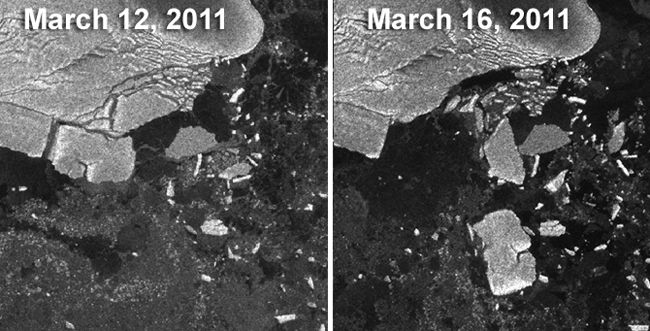
Japan Tsunami Broke Huge Icebergs Off Antarctica

The massive March 11 Japan earthquake and its ensuing tsunami were so powerful that they broke off huge icebergs thousands of miles away in Antarctica, according to a new study.
The calving of icebergs (where a huge chunk of ice breaks off from a glacier or ice shelf) from the Sulzberger Ice Shelf in Antarctica was linked to the tsunami, which originated with the magnitude 9.0 earthquake off the coast of the Japanese island of Honshu, by satellite observations of the Antarctic coast immediately after the earthquake.
Icebergs have been reported to calve following earthquakes before, including after the magnitude 6.3 earthquake that struck Christchurch, New Zealand, on Feb 22. But the new finding marks the first direct observation of such a connection between tsunamis and iceberg calving.
After the Japan tsunami was triggered in the Pacific Ocean, Kelly Brunt, a cryosphere specialist at Goddard Space Flight Center in Greenbelt, Md., and colleagues immediately looked south — really far south. Using multiple satellite images, Brunt, Emile Okal of Northwestern University and Douglas MacAyeal of the University of Chicago were able to observe new icebergs floating off to sea shortly after the sea swell of the tsunami reached Antarctica.
"In the past, we've had calving events where we've looked for the source. It's a reverse scenario — we see a calving and we go looking for a source," Brunt said. "We knew right away this was one of the biggest events in recent history — we knew there would be enough swell. And this time we had a source."
To sum up the dynamics of the event: An earthquake off the coast of Japan caused massive waves to explode out from its epicenter. Swells of water swarmed toward an ice shelf in Antarctica, 8,000 miles (13,600 kilometers) away, and about 18 hours after the earthquake occurred, those waves broke off several chunks of ice that together equaled about two times the surface area of Manhattan. According to historical records, this particular piece of ice hadn't budged in at least 46 years before the tsunami came along.
In what could be one of the more lasting observations from this whole event, the bay in front of the Sulzberger shelf was largely lacking sea ice at the time of the tsunami. Sea ice is thought to help dampen swells that might cause this kind of calving. At the time of the Sumatra tsunami in 2004, the potentially vulnerable Antarctic fronts were buffered by a lot of sea ice, Brunt said, and scientists observed no calving events that they could tie to that tsunami.
Sign up for the Live Science daily newsletter now
Get the world’s most fascinating discoveries delivered straight to your inbox.
"There are theories that sea ice can protect from calving. There was no sea ice in this case," Brunt said. "It's a big chunk of ice that calved because of an earthquake 13,000 kilometers away. I think it's pretty cool."
The study was published today (Aug 8) in the online edition of the Journal of Glaciology.
Most Popular

